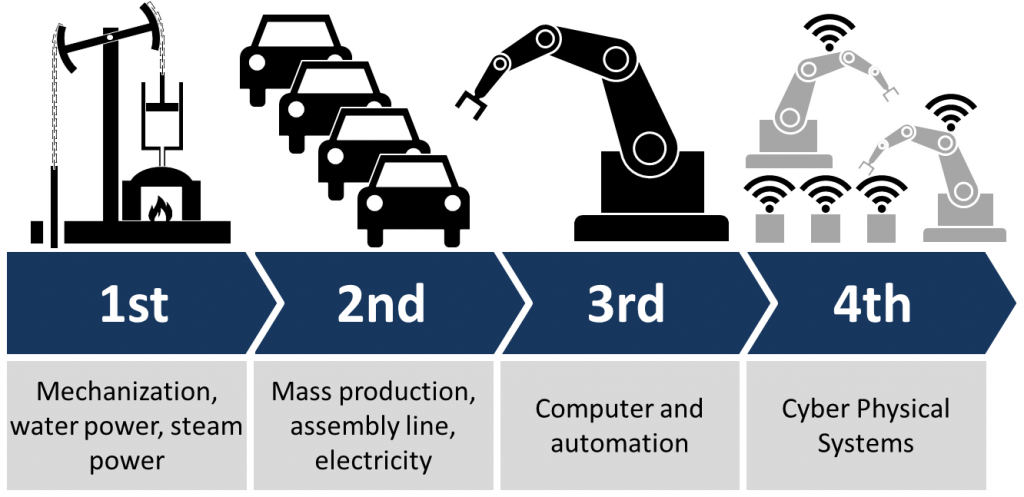
An evolution, not a revolution
In spite of talk of a revolution, the path for most companies to Industry 4.0 is likely to be more of an evolutionary process. It starts with a whir rather than a bang. It doesn’t mean that robots and autonomous machines will replace humans as some predict.
What’s it all about
The term Industry 4.0 was devised by the German government several years ago to promote advanced technology. It’s the umbrella term for a number of technologies that are already transforming manufacturing. These technologies connect the physical world with the digital world, resulting in more seamless interaction between the two.
There is a similar concept between Industry 4.0 and the Internet of Things (IoT), i.e. connecting a variety of things together via networks so that they can talk and respond to one another proactively, without the need for human interaction. But there is a distinct difference as the IoT is largely focused on connecting everyday consumer objects together. Industry 4.0 is much more focused on the manufacturing process and combining the IoT philosophy with industry to help create smart factories and ultimately smart products.
Industry 4.0, or smart factory, describes a new age of digitally enabled manufacturing whereby computers can control automated production lines. It’s an initiative to drive change in the manufacturing and engineering sectors by combining the digital world and that of industrial production to create smart manufacturing facilities.
It is the bringing together of robots, interconnected devices and fast networks of data within a factory environment, basically to make the factory more productive and to execute the routine tasks that are best done by robots and not best done by humans.
Some of the expected benefits include productivity and efficiencies along with greater traceability bought about by automating manual processes where possible, with greater flexibility in creating highly personalised or configured products on a mass scale.
Separating the fact from the fiction
It’s not just another fad…
Industry 4.0 is not viewed as just another fad, it’s a way to increase productivity, reduce costs and boost revenues. The idea is to transform manufacturing from a one-way, step-by-step process to a closed-loop process, with complete visibility and seamless flow of data from every point in the loop to every other point enabling monitoring and control.
It’s not just for the big businesses…
Industry 4.0 is not just for large organisations, manufacturers of all sizes can benefit. The key question for manufacturers regardless of size is not which new technology they should adopt, but which advantages they need to gain to stay competitive and the steps they need to take to get there. Enabling communication or collecting process data from existing equipment is easier and faster than ever before and is more cost-effective than replacing equipment. For example, cloud computing options are far simpler to implement and require less time and fewer resources to go live with no huge capital investment.
Robots are not about to take over…
There is a misconception that Industry 4.0 will result in mass unemployment. The media is partly responsible for this, with scaremongering headlines about how ‘robots are taking our jobs’. The reality is if businesses invest in training programmes and staff show a willingness to embrace change, Industry 4.0 is likely to be a creator of jobs.
Where is our industry heading?
Continuous improvement is key to making a success of Industry 4.0. Customers want to get the best out of the manufacturing processes. They would like better and more; step changes in quality, efficiency and effectiveness. Companies always need to think and plan about how they can get better, challenging the way they think and planning for the future.
The quality of data being captured in the first instance is vital to the success of Industry 4.0. This ensures the information used to make decisions on behalf of the company is good.
Inevitably there are some drawbacks, including: agreeing the language each machine uses to communicate and respond to one another. Security, the threat of cyber attacks and terrorism. There have been some recent high-profile cases exposing how vulnerable data and systems can be. And maintenance of the 4.0 systems, with the potential for increases in process downtime.
The first logical step is don’t run before you can walk. Make sure data isn’t siloed, increase visibility so that there is a clear view across departments. This will enable business to curtail wastage and increase labour efficiency, making it easier to see orders and optimise production schedules. Manufacturers view connectivity being the link to all this, using real-time information flow to discover new insights from data and acting upon those insights quickly to create value through new products and processes.
The UK manufacturing industry can’t afford to stand still if it’s going to deliver greater value to customers, improve productivity and remain competitive on the world stage. Transformation is crucial for the sector. The majority will have to invest in new technology to meet customer expectations, and most say it will fundamentally change the expectations their customers will have from them. Both will have a major impact on the skills we will need from our current and future workforce.
For more information on Industry 4.0 and Smart Manufacturing, visit:
https://en.wikipedia.org/wiki/Industry_4.0
https://en.wikipedia.org/wiki/Smart_manufacturing
https://www.engineering.com/AdvancedManufacturing/ArticleID/16521/What-Is-Industry-40-Anyway.aspx
https://www.mckinsey.com/business-functions/operations/our-insights/manufacturings-next-act

